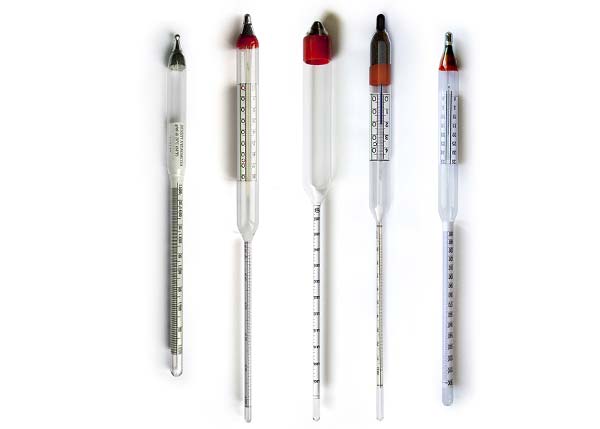Hydrometers, Thermometers & Chrometers are all available for measuring in the electroplating process. A hydrometer is an instrument used for measuring the relative density of liquids based on the concept of buoyancy. They are typically calibrated and graduated with one or more scales such as specific gravity. A hydrometer usually consists of a sealed hollow glass tube with a wider bottom portion for buoyancy, a ballast such as lead or mercury for stability, and a narrow stem with graduations for measuring. The liquid to test is poured into a tall container, often a graduated cylinder, and the hydrometer is gently lowered into the liquid until it floats freely. The point at which the surface of the liquid touches the stem of the hydrometer correlates to relative density. Hydrometers can contain any number of scales along the stem corresponding to properties correlating to the density. Hydrometers are calibrated for different uses, such as a lactometer for measuring the density (creaminess) of milk, a saccharometer for measuring the density of sugar in a liquid, or an alcoholometer for measuring higher levels of alcohol in spirits. The hydrometer makes use of Archimedes’ principle: a solid suspended in a fluid is buoyed by a force equal to the weight of the fluid displaced by the submerged part of the suspended solid. The lower the density of the fluid, the deeper a hydrometer of a given weight sinks; the stem is calibrated to give a numerical reading.
Hydrometers Specific gravity of a solution being tested, using a hydrometer, is often a useful measurement. Use a precision “weighed” glass tube, calibrated to show the specific gravity. Chromium plating baths and iron content in acid zinc are just two examples of applications.
Thermometers These thermometers need to be partially submerged to a known depth to accurately register temperature readings. They have a marked line that indicates what level they need to be submerged in order to provide a temperature reading. They are commonly used to measure temperatures readings in vessels and beakers when the sample to be measured is shallow.
Chrometers used for measuring chromic acid




